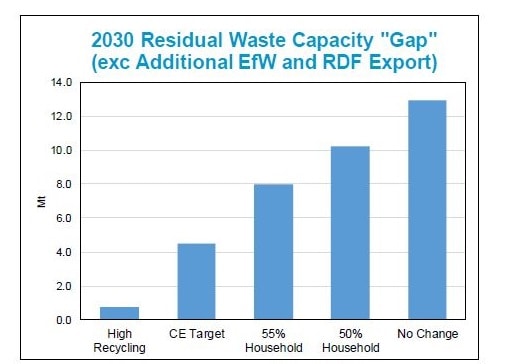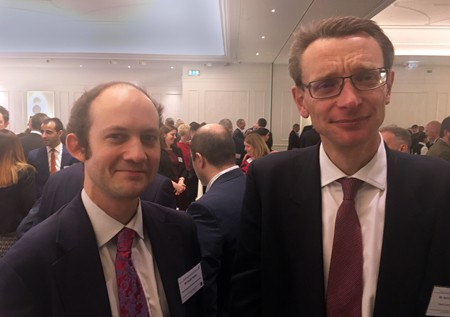The Environmental Services Association today (30 November) warned that the UK will face a six million tonnes waste treatment capacity gap by 2030.
Its figure follows a detailed report released today (30 November) by consultancy Tolvik which independently assessed the potential capacity gap with analysis also of six other reports on the topic.

ESA has warned that the UK will face a six million tonnes waste treatment capacity gap by 2030, including energy from waste
Tolvik puts forward five scenarios for the gap in waste treatment infrastructure in 2030 which are dependent on the recycling rate – which ranges from a ‘No Change’ scenario to a ‘High Recycling’ scenario.
ESA
In ESA’s interpretation of the report the association assumes that the combined “municipal” recycling rate will be 57% in 2030, equating to a capacity gap of 5.7 million tonnes.
Tolvik found that if the recycling rate in 2030 is 57%, the UK will generate around 26.8mt of residual waste. This is a combined household recycling rate of 50%, and a municipal C&I waste recycling rate of 63%.
Using analysis from reports produced by Suez, Biffa and Eunomia, as well as unpublished analyses from Viridor, FCC, and SLR, Tolvik estimates that capacity in the UK which is currently operational or in construction is 16.6mt.
In this instance, it is projected that in 2030 there will be a “gap” in residual waste treatment capacity of 10.2mt.
Exports
When this is combined with a projected 2.5mtpa of RDF exports in 2030 (the median figure from the estimates included in the reports), along with an estimated 2.0mtpa of additional dedicated EfW capacity constructed in the UK before 2022, the capacity gap reduces to 5.7 million tonnes.

Chart shows capacity gap predictions based on recycling rate
Commenting on the UK’s recycling rate in 2030, ESA said: “Without policy intervention the industry believes that recycling rates will remain at around current levels. These are circa 45% for household waste and 60% for the commercial waste which is similar to household waste. The combined current “municipal” recycling rate is around 50%.”
“At the industry consensus of 50-55% municipal recycling, the forecast treatment capacity gap is almost 6 million tonnes in 2030, even after factoring in a continuation of waste exports to the EU and the development of some currently unplanned facilities.”
ESA suggests in order to achieve much higher recycling rates this will require significant and “potentially costly” policy intervention to boost recycling markets.
“Clear signal”
In order to “close the gap” the association has called for Government to send a “clear signal” as to how much post-recycling capacity it wants and provide the long term policy stability that tells investors that their projects will not be undermined in the future.
Commenting on the report, ESA executive director Jacob Hayler said the waste industry is “alarmed” by the emergence of a critical lack of infrastructure.
“ESA’s members have invested around £5 billion in UK recycling and recovery facilities in the past five years and completed detailed modelling exercises to understand what further investment is required for the future,” he said.
“Their conclusions are stark: by 2030 the UK needs faces a shortfall of six million tonnes of waste treatment capacity. Without action, this means that five million UK homes will see their waste buried in landfill when it could be used to generate energy, helping to safeguard the UK’s energy supplies.”
“We urgently need the government to recognise the waste crisis the UK is facing and give the industry the long term clarity it needs to invest in new energy from waste facilities.”
“Uncertainty”
Tolvik director Adrian Judge said: “Current policy uncertainty, particularly in England, is discouraging investment into the sector, which desperately needs new infrastructure both for recycling and for energy from waste facilities.
“This is creating the risk of a mismatch between waste tonnages and available treatment capacity, which could lead to significant quantities of waste without a home by 2030.”
Related links
Environmental Services Association
The post ESA in fresh capacity gap warning appeared first on letsrecycle.com.
Source: letsrecycle.com Waste Managment



